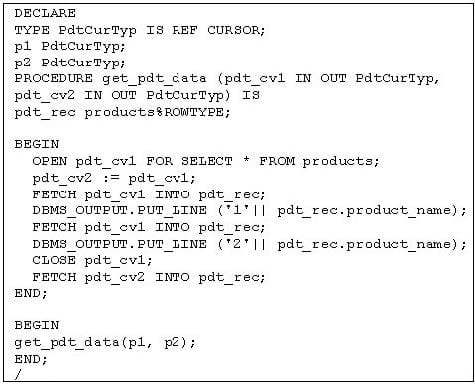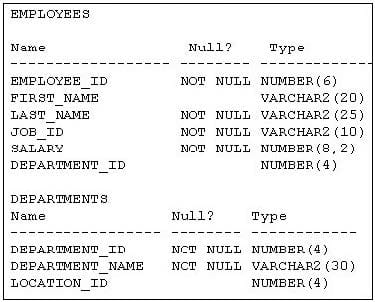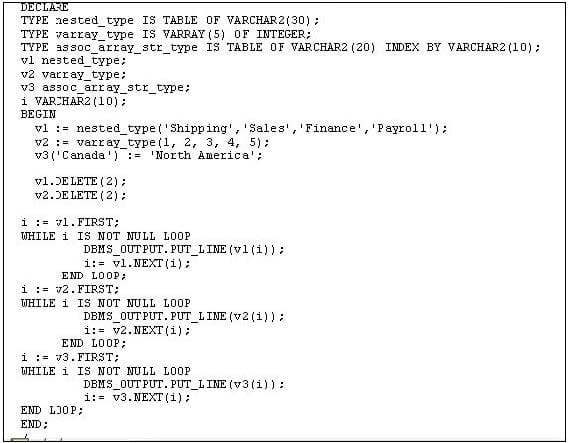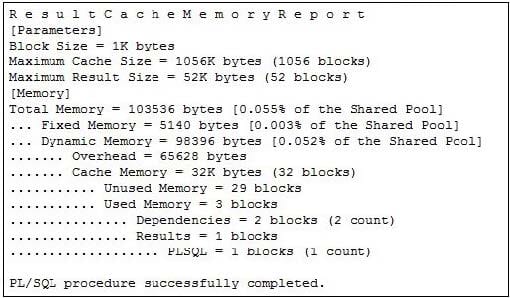Exam Details
Exam Code
:1Z0-148Exam Name
:Oracle Database: Advanced PL/SQLCertification
:Oracle CertificationsVendor
:OracleTotal Questions
:243 Q&AsLast Updated
:Mar 26, 2025
Oracle Oracle Certifications 1Z0-148 Questions & Answers
-
Question 161:
Examine the structure of the PRODUCTS table. Name Null? Type
PRODUCT_ID NOT NULL NUMBER(6) PRODUCT_NAME VARCHAR2(50) CATEGORY_ID NUMBER(2) SUPPLIER_ID NUMBER(6) LIST_PRICE NUMBER(8,2)
View the Exhibit and examine the PL/SQL block.
On execution, the PL/SQL block generates the following error:
ORA-01001: invalid cursor
What could be the reason?

A. Both the cursor variable arguments should have been passed in IN mode.
B. The contents of one cursor variable cannot be assigned to another cursor variable using the := operator.
C. The CLOSE statement closes both the cursor variables, therefore the last FETCH statement cannot execute.
D. The name of the cursor variables defined and the name of the cursor variables passed as arguments must be the same.
-
Question 162:
View the Exhibit and examine the structures of the EMPLOYEES and DEPARTMENTS tables.
Examine the PL/SQL block that you execute to find the average salary for employees in the 'Sales'
department:
DECLARE
TYPE emp_sal IS TABLE OF employees.salary%TYPE INDEX BY VARCHAR2(20);
v_emp_sal emp_sal;
PROCEDURE get_sal(p_dept_name VARCHAR2, p_arr OUT emp_sal) IS
BEGIN
SELECT AVG(salary) INTO p_arr(p_dept_name)
FROM employees WHERE department_id=
(SELECT department_id FROM departments
WHERE department_name=p_dept_name);
END get_sal;
BEGIN
get_sal('Sales',v_emp_sal);
DBMS_OUTPUT.PUT_LINE( v_emp_sal('Sales'));
END;
/
What is the outcome?

A. It executes successfully and gives the correct output.
B. It generates an error because the associative array definition is not valid.
C. It generates an error because an associative array cannot be passed to a procedure in OUT mode.
D. It generates an error because an associative array cannot be used with the SELECT INTO statement.
-
Question 163:
View the Exhibit and examine the output.
Which statement is an inference from the output?

A. The class file is pinned into the Java pool.
B. The class file has been loaded into the shared library.
C. Java class methods in the Java class file have been published.
D. The loadjava command has been executed to load the Java source and class files.
-
Question 164:
Examine the code in the following PL/SQL block:
DECLARE
TYPE NumList IS TABLE OF INTEGER;
List1 NumList := NumList(11,22,33,44);
BEGIN
List1.DELETE(2);
DBMS_OUTPUT.PUT_LINE
( 'The last element# in List1 is ' || List1.LAST ||
' and total of elements is '||List1.COUNT);
List1.EXTEND(4,3);
END;
/
Which two statements are true about the above code? (Choose two.)
A. LAST and COUNT give different values.
B. LAST and COUNT give the same values.
C. The four new elements that are added contain the value 33.
D. The four new elements that are added contain the value 44.
-
Question 165:
Which two statements are true about the working of fine-grained access? (Choose two.)
A. Security policies can be associated only with tables, but not with views.
B. Different policies can be used for SELECT, INSERT, UPDATE, and DELETE statements.
C. User statements are dynamically modified by the Oracle server through a security policy function.
D. Fine-grained access control policies always remain in effect until they are dropped from a table or view.
-
Question 166:
View the Exhibit and examine the code in the PL/SQL block.
The PL/SQL block generates an error on execution. What is the reason?

A. The DELETE(n) method cannot be used with varrays.
B. The DELETE(n) method cannot be used with nested tables.
C. The NEXT method cannot be used with an associative array with VARCHAR2 key values.
D. The NEXT method cannot be used with a nested table from which an element has been deleted.
-
Question 167:
Which two statements are true about the tuning of PL/SQL code? (Choose two.)
A. Redundant SQL statements in PL/SQL code should be avoided.
B. Implicit data type conversion in PL/SQL code can improve performance.
C. Usage of the NOT NULL constraint in PL/SQL code can degrade performance.
D. If you have one PL/SQL program unit instead of multiple smaller executable sections, performance can be improved.
-
Question 168:
You issue this command to create a table called LOB_STORE:
CREATE TABLE lob_store
(lob_id NUMBER(3),
photo BLOB DEFAULT EMPTY_BLOB(),
cv CLOB DEFAULT NULL,
ext_file BFILE DEFAULT NULL)
/
What is the outcome?
A. The table is created successfully.
B. It generates an error because DEFAULT cannot be set to EMPTY_BLOB() during table creation.
C. It generates an error because DEFAULT cannot be set to null for a CLOB column during table creation.
D. It generates an error because DEFAULT cannot be set to null for a BFILE column during table creation.
-
Question 169:
Which two statements are true about the migration of BasicFile to the SecureFile format by using the DBMS_REDEFINITION package? (Choose two.)
A. It can be performed only on tables with a single LOB column.
B. It automatically creates an interim table during the migration process.
C. It allows the table that is migrated to be accessed throughout the migration process.
D. It requires free space that is at least equal to the space used by the table that is migrated.
E. It requires all constraints defined on the original table to be re-created manually after the migration.
-
Question 170:
You executed this command to gather information about the memory allocation for storing query results:
SQL> execute dbms_result_cache.memory_report
View the Exhibit and examine the output for the execution of the
DBMS_RESULT_CACHE.MEMORY_REPORT procedure.
Which two statements are true about the output in the Exhibit? (Choose two.)

A. In total, four blocks are used by the result cache.
B. Currently 52 KB is allocated to the result cache.
C. Currently 32 KB is allocated to the result cache.
D. The result cache can be increased by 65628 bytes.
Related Exams:
1Z0-020
Oracle8i: New Features for Administrators1Z0-023
Architecture and Administration1Z0-024
Performance Tuning1Z0-025
Backup and Recovery1Z0-026
Network Administration1Z0-034
Upgrade Oracle9i/10g OCA to Oracle Database OCP1Z0-036
Managing Oracle9i on Linux1Z0-041
Oracle Database 10g: DBA Assessment1Z0-052
Oracle Database 11g: Administration Workshop I1Z0-053
Oracle Database 11g: Administration II
Tips on How to Prepare for the Exams
Nowadays, the certification exams become more and more important and required by more and more enterprises when applying for a job. But how to prepare for the exam effectively? How to prepare for the exam in a short time with less efforts? How to get a ideal result and how to find the most reliable resources? Here on Vcedump.com, you will find all the answers. Vcedump.com provide not only Oracle exam questions, answers and explanations but also complete assistance on your exam preparation and certification application. If you are confused on your 1Z0-148 exam preparations and Oracle certification application, do not hesitate to visit our Vcedump.com to find your solutions here.